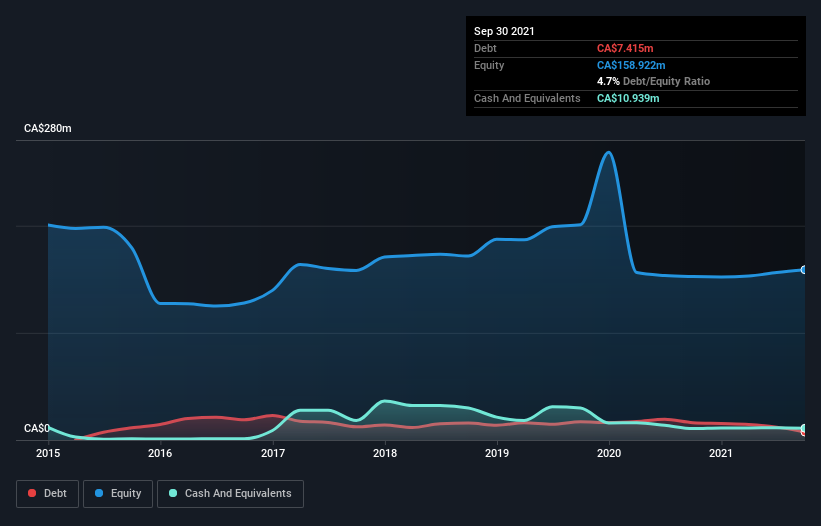Questerre Energy (TSE:QEC) Has A Pretty Healthy Balance Sheet
Legendary fund manager Li Lu (who Charlie Munger backed) once said, 'The biggest investment risk is not the volatility of prices, but whether you will suffer a permanent loss of capital.' So it might be obvious that you need to consider debt, when you think about how risky any given stock is, because too much debt can sink a company. We note that Questerre Energy Corporation (TSE:QEC) does have debt on its balance sheet. But the real question is whether this debt is making the company risky.
When Is Debt Dangerous?
Debt is a tool to help businesses grow, but if a business is incapable of paying off its lenders, then it exists at their mercy. Ultimately, if the company can't fulfill its legal obligations to repay debt, shareholders could walk away with nothing. While that is not too common, we often do see indebted companies permanently diluting shareholders because lenders force them to raise capital at a distressed price. By replacing dilution, though, debt can be an extremely good tool for businesses that need capital to invest in growth at high rates of return. The first thing to do when considering how much debt a business uses is to look at its cash and debt together.
Check out our latest analysis for Questerre Energy
How Much Debt Does Questerre Energy Carry?
You can click the graphic below for the historical numbers, but it shows that Questerre Energy had CA$7.42m of debt in September 2021, down from CA$16.2m, one year before. However, it does have CA$10.9m in cash offsetting this, leading to net cash of CA$3.52m.
A Look At Questerre Energy's Liabilities
Zooming in on the latest balance sheet data, we can see that Questerre Energy had liabilities of CA$12.7m due within 12 months and liabilities of CA$21.0m due beyond that. Offsetting these obligations, it had cash of CA$10.9m as well as receivables valued at CA$3.45m due within 12 months. So its liabilities total CA$19.4m more than the combination of its cash and short-term receivables.
This deficit isn't so bad because Questerre Energy is worth CA$64.3m, and thus could probably raise enough capital to shore up its balance sheet, if the need arose. However, it is still worthwhile taking a close look at its ability to pay off debt. Despite its noteworthy liabilities, Questerre Energy boasts net cash, so it's fair to say it does not have a heavy debt load!
Although Questerre Energy made a loss at the EBIT level, last year, it was also good to see that it generated CA$5.5m in EBIT over the last twelve months. There's no doubt that we learn most about debt from the balance sheet. But ultimately the future profitability of the business will decide if Questerre Energy can strengthen its balance sheet over time. So if you want to see what the professionals think, you might find this free report on analyst profit forecasts to be interesting.
But our final consideration is also important, because a company cannot pay debt with paper profits; it needs cold hard cash. While Questerre Energy has net cash on its balance sheet, it's still worth taking a look at its ability to convert earnings before interest and tax (EBIT) to free cash flow, to help us understand how quickly it is building (or eroding) that cash balance. Happily for any shareholders, Questerre Energy actually produced more free cash flow than EBIT over the last year. There's nothing better than incoming cash when it comes to staying in your lenders' good graces.
Summing up
Although Questerre Energy's balance sheet isn't particularly strong, due to the total liabilities, it is clearly positive to see that it has net cash of CA$3.52m. The cherry on top was that in converted 173% of that EBIT to free cash flow, bringing in CA$9.5m. So we are not troubled with Questerre Energy's debt use. When analysing debt levels, the balance sheet is the obvious place to start. But ultimately, every company can contain risks that exist outside of the balance sheet. These risks can be hard to spot. Every company has them, and we've spotted 2 warning signs for Questerre Energy you should know about.
If you're interested in investing in businesses that can grow profits without the burden of debt, then check out this free list of growing businesses that have net cash on the balance sheet.
This article by Simply Wall St is general in nature. We provide commentary based on historical data and analyst forecasts only using an unbiased methodology and our articles are not intended to be financial advice. It does not constitute a recommendation to buy or sell any stock, and does not take account of your objectives, or your financial situation. We aim to bring you long-term focused analysis driven by fundamental data. Note that our analysis may not factor in the latest price-sensitive company announcements or qualitative material. Simply Wall St has no position in any stocks mentioned.
Have feedback on this article? Concerned about the content? Get in touch with us directly. Alternatively, email editorial-team (at) simplywallst.com.

 Yahoo Finance
Yahoo Finance 
